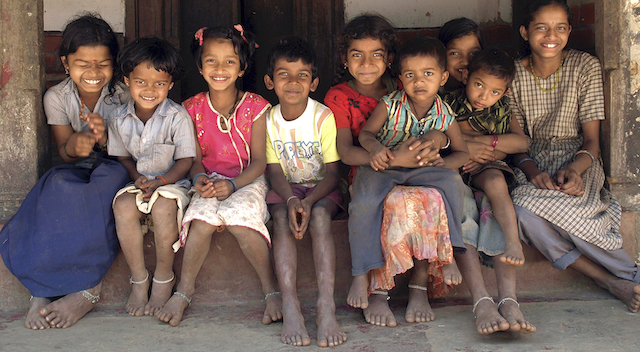
Why should we all pay greater attention to girls’ education and women’s empowerment?
Here is the answer by someone speaking from personal experience, proven right all over the world for all to see:
“If women are empowered, there is more development in society” – Droupadi Murmu
Find this and other speeches by the President of India >>
Learn more
Is tribal identity relevant in today’s world?
What if we considered everything around us throughout the world?
How many people depend on forest resources and what is the Forest Rights Act all about?
How many languages are “potentially endangered”?
Who are Scheduled Tribes, and what sets them apart from “mainstream” society?
What can we learn from the success stories of India’s tribal communities?
Is the Adivasi way of life a utopian one?
How many States and Union Territories does India have?
Which are India’s North Eastern states?
What makes the Biodiversity Act and The Hyderabad biodiversity pledge important for all citizens across India and beyond?
Do historians regard oral history as inferior to written accounts?
What makes a place safe for women? Learn more from India’s 15th President Droupadi Murmu
How to help children, women and other victims of human trafficking?
Where and when does the Human Rights Commission intervene? Visit the website of the National Human Rights Commission: www.nhrc.nic.in (Government of India) >>
Official details: State/UT wise population of STs
NAME OF THE PARTICULARLY VULNERABLE TRIBAL GROUPS (PTGs) (EARLIER CALLED AS PRIMITIVE TRIBAL GROUPS) – STATE / UT WISE
[UT = Union Territories].
1. Andhra Pradesh
1. Bodo Gadaba
2. Bondo Poroja
3. Chenchu
4. Dongria Khond
5. Gutob
Gadaba
6. Khond Poroja
7. Kolam
8. Kondareddis
9. Konda Savaras
10. Kutia Khond
11. Parengi Poroja
12. Thoti
2. Bihar (including Jharkhand)
13. Asurs
14. Birhor
15. Birjia
16. Hill Kharia
17. Korwas
18. Mal Paharia
19. Parhaiyas
20. Sauria Paharia
21. Savar
3. Gujarat
22. Kathodi
23. Kotwalia
24. Padhar
25. Siddi
26. Kolgha
4. Karnataka
27. Jenu Kuruba
28. Koraga
5. Kerala
29. Cholanaikayan (a section of Kattunaickans)
30. Kadar
31. Kattunayakan
32. Kurumbas
33. Koraga
6. Madhya Pradesh (including Chhattisgarh)
34. Abujh Marias
35. Baigas
36. Bharias
37. Hill Korbas
38. Kamars
39. Saharias
40. Birhor
7. Maharashtra
41. Katkaria (Kathodia)
42. Kolam
43. Maria Gond
8. Manipur
44. Marram Nagas
9. Orissa
45. Birhor
46. Bondo
47. Didayi
48. Dongria-Khond
49. Juangs
50. Kharias
51. Kutia Kondh
52. Lanjia Sauras
53. Lodhas
54. Mankidias
55. Paudi Bhuyans
56. Soura
57. Chuktia Bhunjia
10. Rajasthan
58. Seharias [Sahariya]
11. Tamil Nadu
59. Kattu Nayakans
60. Kotas
61. Kurumbas
62. Irulas
63. Paniyans
64. Todas
12. Tripura
65. Reangs
13. Uttar Pradesh (including Uttarakhand)
66. Buxas
67. Rajis
14. West Bengal
68. Birhor
69. Lodhas
70. Totos
15. Andaman & Nicobar Islands
71. Great Andamanese
72. Jarawas
73. Onges
74. Sentinelese
75. Shom Pens
Source: State/UT wise population of STs and their percentage to the total population in the respective states/UTs and to the total STs population in the Country, as per Census 2001 | National Commission for Scheduled Tribes
Address: https://www.ncst.gov.in/content/stateut-wise-population-sts-and-their-percentage-total-population-respective-statesuts-and
Date Visited: 30 July 2021
Backup file dated 6 April 2017 (PDF, 19 KB)
Find up-to-date information provided by, for and about Indian authors, researchers, officials, and educators
List of web portals covered by the present Custom search engine
Ashoka Trust for Research in Ecology and the Environment (ATREE) – www.atree.org
Freedom United – www.freedomunited.org
Government of India (all websites ending on “.gov.in”)
Kalpavriksh Environmental Action Group – https://kalpavriksh.org
Shodhganga (a reservoir of Indian theses) – https://shodhganga.inflibnet.ac.in
Survival International – www.survivalinternational.org
UCLA Digital Library – https://digital.library.ucla.edu
Unesco – https://en.unesco.org
Unesco digital library – https://unesdoc.unesco.org
Unicef – www.unicef.org
United Nations – www.un.org/en
Video Volunteers – www.videovolunteers.org
WorldCat (“the world’s largest library catalog, helping you find library materials online”) – https://worldcat.org
To search Indian periodicals, magazines, web portals and other sources safely, click here. To find publishing details for Shodhganga’s PhD search results, click here >>
Search tips
Combine the name of any particular state, language or region with that of any tribal (Adivasi) community.
Add keywords of special interest (music, poetry, dance just as health, sacred grove and biodiversity); learn about the rights of Scheduled Tribes such as the “Forest Rights Act” (FRA); and the United Nations “Declaration on the Rights of Indigenous Peoples”, “Universal Declaration of Human Rights”, “women’s rights”, or “children’s right to education”.
Ask a question that includes “tribal” or “Adivasi”, for instance: “Adivasi way of life better?” (or “tribal way of life worse?”)
Specify any particular issue or news item (biodiversity, bonded labour and human trafficking, climate change, ecology, economic development, ethnobotany, ethnomedicine, global warming, hunter-gatherers in a particular region or state, prevention of rural poverty, water access).
For official figures include “scheduled tribe ST” along with a union state or region: e.g. “Chhattisgarh ST community”, “Himalayan tribe”, “Scheduled tribe Tamil Nadu census”, “ST Kerala census”, “Particularly Vulnerable Tribal Group Jharkhand”, “PVTG Rajasthan”, “Adivasi ST Kerala”, “Adibasi ST West Bengal” etc.
In case the Google Custom Search window is not displayed here try the following: (1) toggle between “Reader” and regular viewing; (2) in your browser’s Security settings select “Enable JavaScript” | More tips >>
Note: hyperlinks and quotes are meant for fact-checking and information purposes only | Disclaimer >>
Some clarifications on caste-related issues by reputed scholars >>